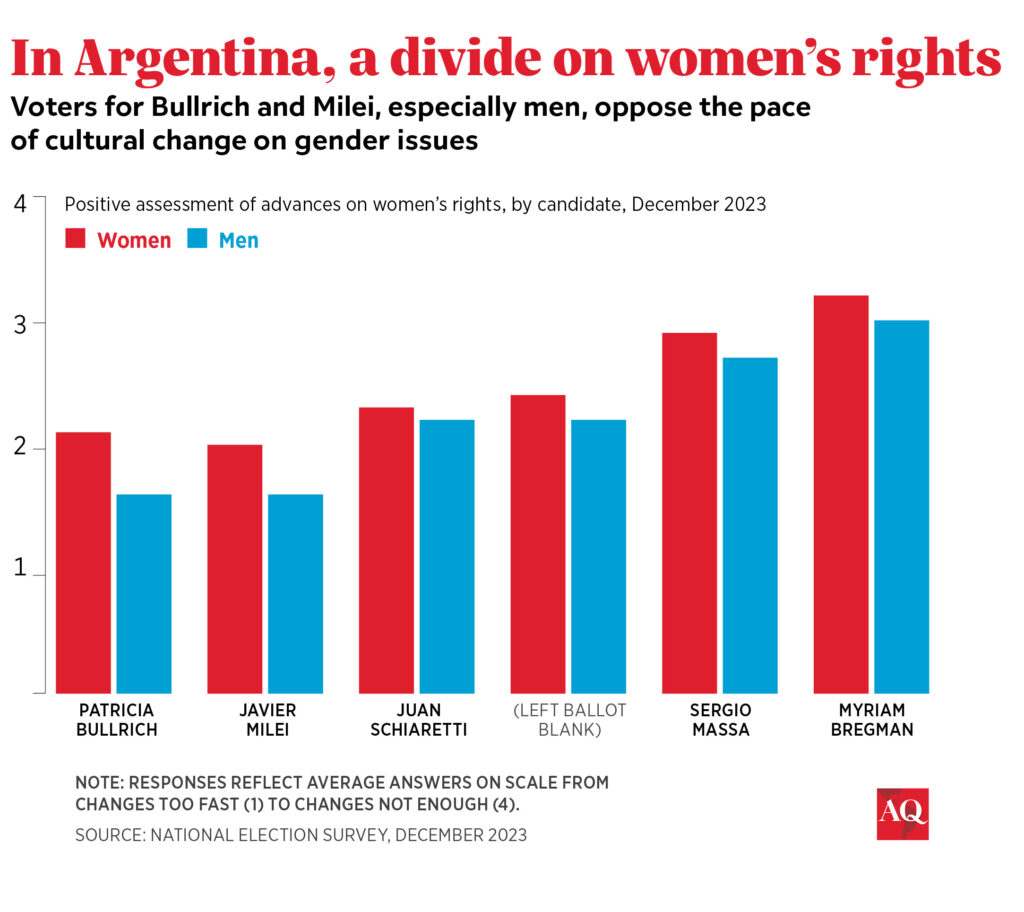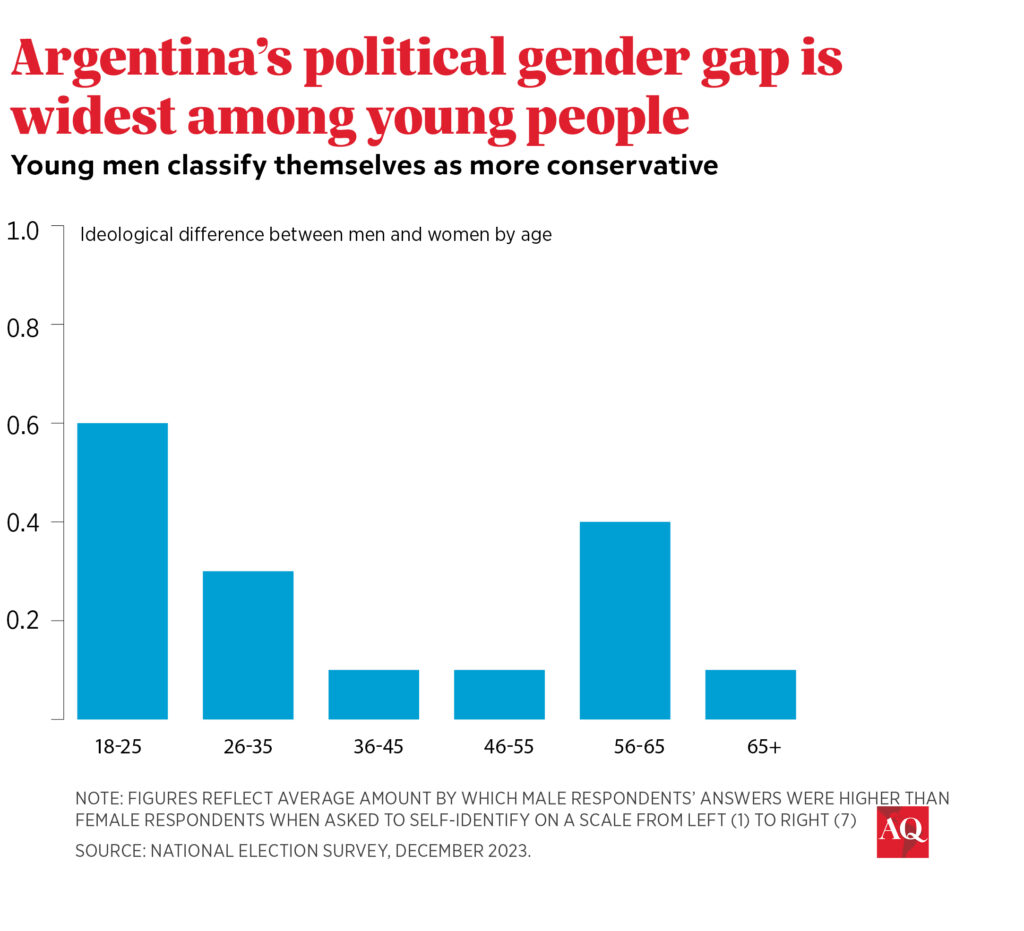Since Javier Milei’s election last November as Argentina’s first right-wing outsider president, many articles have been dedicated to his radical policy proposals and eccentric habits. But there’s been less attention to who his voters are, and what they believe.
One popular narrative holds that Milei’s supporters don’t necessarily agree with him ideologically—they’re simply angry over the country’s continued economic slide, disaffected by the political class and generally uninformed. But we reached a very different finding after fielding a national survey in December.
Our results show that Milei’s supporters are considerably more aligned with his preferences than has been previously recognized. The core voters of his newly created La Libertad Avanza party are not just discontented with the political establishment: They also have right-wing preferences on salient economic and social issues. What’s more, his first-round voters tend to be younger, and men outnumber women significantly. An ideological divide is emerging among young male and female Argentinians.

Anatomy of an electorate
Who are Milei’s voters? We fielded a representative survey of 2400 Argentine voters during the third week of December in order to find out.
In the first-round presidential election of October 23, Milei won 30% of the national vote, with strong showings outside of the metropolitan region of Buenos Aires. His support grew to 55.7% in the runoff election on November 19, collecting most votes from the center-right candidate Patricia Bullrich and from the non-Kirchnerist Peronist Juan Schiaretti. More than 80% of Bullrich voters shifted to Milei, along with about 40% of Schiaretti’s voters.
While the media often depicts Milei’s vote as anti-establishment, non-ideological and angered by the country’s dismal economic performance (inflation peaked at 211% in 2023) and increasing insecurity, we find voters who are more aligned with Milei’s ideology: conservative, with pro-market preferences. They’re opposed to the pace of cultural change on gender issues; they reject abortion legalization and gay marriage. They also think that taxes kill employment and welfare is only acceptable on a temporary basis.
We do not know how stable these preferences will be, but what’s clear is that the country is seeing the emergence of a right-wing electorate. Milei’s first round voters are the most right-wing, with values of 5.3 on a scale from 1-7, with the median voter at 4. What’s more, they are not very distant from voters who chose Bullrich (4.9 for female and 5.1 for males), which explains the ease of vote transfers between both rounds, given also that around 54% of voters in the first round had conservative attitudes. These voters are considerably to the right of supporters of Peronist candidate Sergio Massa, who received 37% of the vote in the first round, and the 3% who choose left-wing candidate Myriam Bregman.
But conservative Argentine voters seem to be the only ones experiencing an ideological gender gap. Milei’s and Bullrich’s voters are the most in disagreement with advances on gender rights and most likely to think that taxes kill jobs. But the views of their female and male voters are significantly different: Male voters for both candidates are more conservative than female on both social and economic issues—and this gender difference is not as salient for voters of other candidates.
Remarkably, this conservative gender gap seems to be driven by young voters. Our findings show a significant difference between male and female young voters between 18 and 25. Male voters between 18 and 25 are more conservative than those of any other age group, and it’s in this group that we see the largest gap between men and women.

The ideological gender divide among young people—a phenomenon that’s taking place across the globe—explains Milei’s male-skewed electoral support and points to a gap that could shape electoral politics for years to come. For voters aged 18-25, support for Javier Milei in the first round was 55.8% for men compared to just 33.8% for women. For voters between 25 and 30, the gap was smaller but still significant: 44.2% for men compared to 33.4% among women.
While Argentina already underwent an ideological shift to the right back in the 1990s, the new political and gender split on view in the younger population is certainly new—and opens the possibility of more durable changes, since research suggests early electoral experiences tend to be formative. For Milei, it opens the opportunity to shape a durable electoral coalition. But this would require political skill he has not yet shown—as his administration began with an omnibus policy bill that succumbed to many cuts before being withdrawn from the legislative process.
—
Ernesto Calvo (Ph.D. Northwestern, 2001) is a Professor of Government and Politics at the University of Maryland and the director of the Interdisciplinary Laboratory for Computational Social Sciences (iLCSS).
Gabriel Kessler is Professor of Sociology at the University of La Plata and the University of San Martin, Argentina.
Maria Victoria Murillo is Professor of Political Science and International Affairs and the Director of the Institute of Latin American Studies at Columbia University.
Gabriel Vommaro is Professor of Political Sociology at the EIDAES, Universidad de San Martín, Researcher at the National Research Council, CONICET, in Argentina, and research fellow at the CIPR- Stone Center for Latin American Studies, Tulane University.








